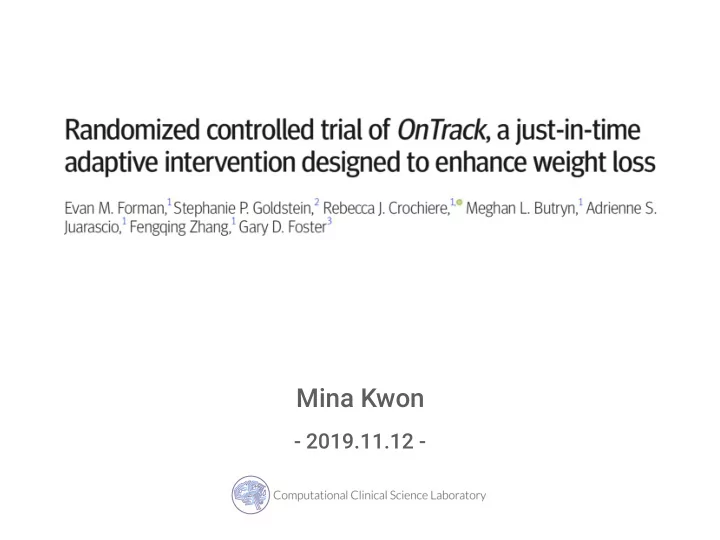

Mina Kwon - 2019.11.12 -
Introduction
Introduction • “mHealth” , mobile health intervention, is a popular option for losing weight. • “Dietary lapses” , non-adherence to reduced calorie dietary prescriptions, is a key challenge for weight management. • “Simplicity of the mHealth” , giving same intervention to all users disconnected in time and place from when they are most needed.
Introduction • Just-in-time adaptive interventions (JITAIs) : collect and analyze data in real time to deliver tailored interventions during moments of need • With basic assumptions that, A. Lapses are more likely during specific contexts , (such as watching television, presence of food cues, negative or positive mood, sleep deprivation) B. Individual difference exists!
Introduction • “ OnTrack (OT) ” , an app-based JITAI and the first JITAI designed to enhance weight loss. 1. using a machine learning algorithm to build increasingly accurate models of adherence VS lapse behavior, 2. predict lapses before they occur 3. deliver interventions when calculated lapse risk is elevated
Primary Aim Examine the additive efficacy of OnTrack in promoting weight loss compared to previous mHealth intervention. “JITAI vs Non-JITAI”
METHOD
Participants • 181 adults with overweight or obesity, seeking weight loss. - Weight Watchers (WW): n = 62 - Weight Watchers + OnTrack (WW + OT): n = 119 • Inclusion criteria - iPhone users - purchase or lent wireless body scale - BMI 25 ~ 50 (kg/m 2 ) • Exclusion criteria - recent weight loss of 5% or more - history of bariatric surgery - pregnant - eating disorder symptomatology
Weight Watchers Intervention • Assign weight watchers points goal designed to achieve negative energy balance (calorie intake < calorie usage) • Nudged toward healthier food choice Beyond the Scale (BTS) Freestyle (FS) Assign smart points goal Same but More zero-point food More Flexible!
OnTrack Intervention • When users enter new data for lapses risk factors, machine learning algorithms update associations between reported risk factors and the absence or presence of a lapse. • Cost-sensitive ensemble models that combined a weighted vote of predictions from logic boost, bagging, random subspace, random forest, and Bayes net. • Combination of group-level and individual-level data.
OnTrack Intervention Group-level Predicting individual’s lapse with existing model algorithm from previous studies based on BTS program. Individual-level Predicting individual’s lapse with previous data of algorithm the same individual -> Personalize existing group-level algorithm to each individual No risk alerts Risk alerts ON 8 weeks 2 weeks
OnTrack Intervention • Alert delivered within several minutes of data update, when the algorithm calculated an elevated risk of lapse 1. Alert 2. Short interventions 3. Long interventions
OnTrack Intervention • Alert delivered within several minutes of data update, when the algorithm calculated an elevated risk of lapse 1. Alert 2. Short interventions 3. Long interventions
Study design Weight Watchers (WW) WW + OnTrack Beyond the 18 40 scale (BTS) Freestyle 44 79 (FS) 62 119 Total
Measures Weight Watchers (WW) WW + OnTrack • Weight (weekly self-measured) • Satisfaction: The Technology Acceptance Model Scales (TAMS) • Perceived accuracy, helpfulness of intervention (1 time / day) - • Dietary lapses • Self report of Lapse triggers (6 times /day)
Data analytic strategy • Difference in weight loss between condition (WW / WW + OT) and by diet type (BTS / FS): 2 x 2 factorial ANCOVA • Difference in Satisfaction between each diet type (BTS / FS): independent sample t-test • Difference in number of lapses across Time and diet type, in OnTrack group only: Repeated measures ANCOVA • Difference in Intervention access across Time and diet type, in on Track group only: Repeated measures ANCOVA • Accuracy of machine learning models : prediction of the model was compared with user-reported lapses. - non-lapse after risk alerts: considered as a true positives
RESULTS
Participant characteristics
RESULTS Weight Loss Satisfaction Main effect (p = 0.7) BTS > FS (p = 0.005) Interaction effect (p = .002)
RESULTS Lapse frequency by week Intervention access (WW + OT condition) (WW + OT condition) Decreased through time (p < .001) No difference through time (p = .67) diet type (p = .58) BTS > FS (p =.01)
RESULTS Access to Short intervention: 46.8% (SD = 26.18) Access to Long intervention: 7.4% (SD = 10.10)
Algorithm Accuracy • Sensitivity (true positives): 69.2% (SD = 24.87) • Specificity (true negatives): 83.8% (SD = 10.37) • Accuracy: BTS > FS
DISCUSSION
Discussions • More weight loss with JITAI only with the BTS program, on which the machine language was originally trained. —> Get along with more strict diet type ? —> Poor generalization of the OnTrack algorithms!
Discussions • Intervention access declined over time —> became familiar with the repeated intervention? • Little access to long intervention —> short and quickly digestible intervention is preferred
Limitations • Weight Watchers (WW-only) condition lacks data of dietary lapses & engagement. • Non lapse after alert might be False positive rather than True positive —> Should be identified! • Mostly white & Female • No Follow-up assessment
Future directions • Replications with a larger RCT • Generalizable JITAI machine learning algorithm • Options for increasing engagement • Solution to reduce burden of entering data
Thank you :)
Recommend
More recommend